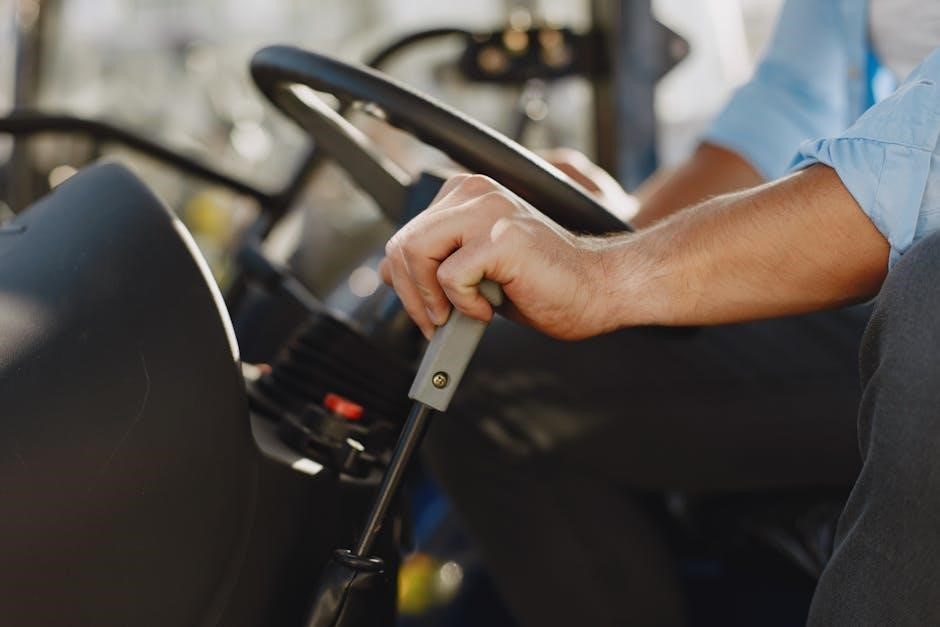
atv manual transmission
What is an ATV Manual Transmission?
An ATV manual transmission is a system that requires the rider to manually select gears. This is achieved using a clutch lever and a foot shifter, giving the rider direct control over the ATV’s power and speed.
Definition and Basic Functionality
An ATV manual transmission is a type of drivetrain system found in some all-terrain vehicles. Unlike automatic transmissions, a manual transmission requires the rider to actively engage and disengage gears using a clutch lever and a foot shifter. This setup provides the rider with direct control over the engine’s power output and the ATV’s speed. By manually selecting the appropriate gear, the rider can optimize performance for various terrains and riding conditions. The basic functionality involves using the clutch to disconnect the engine from the transmission, allowing the rider to shift gears without damaging the engine or transmission components. This direct control allows for more precise maneuvering.
Components of a Manual Transmission in an ATV
An ATV manual transmission comprises several key components working in harmony. The clutch, operated by a lever, disconnects the engine from the transmission, enabling gear changes. Gears of varying sizes provide different torque and speed ratios. A shift drum and forks select the appropriate gear based on the rider’s input. The shift lever, typically foot-operated, allows the rider to engage different gears. Connecting shafts transfer power from the engine through the transmission to the wheels. Seals and gaskets prevent oil leaks, ensuring proper lubrication. Bearings reduce friction between moving parts, enhancing efficiency and durability. These components synchronize seamlessly to provide the rider with control over the ATV’s performance.

Types of Manual Transmissions in ATVs
ATVs utilize various manual transmission types, including traditional manual with clutch, semi-automatic, and dual-clutch transmissions. Each offers a unique blend of rider control and automation for diverse riding preferences.
Traditional Manual (Clutch and Gear Shifting)
The traditional manual transmission in an ATV operates similarly to a motorcycle. It features a clutch lever, typically located on the left handlebar, and a foot shifter. To change gears, the rider must disengage the clutch by squeezing the lever, shift gears using the foot lever, and then smoothly release the clutch while applying throttle.
This system provides the most direct control over the engine’s power output, allowing experienced riders to precisely manage torque and speed for various terrains and riding conditions. Mastering this type of transmission requires practice and coordination but offers a rewarding level of engagement with the machine.
Semi-Automatic Transmissions
Semi-automatic transmissions in ATVs offer a blend of manual control and automated convenience. These transmissions lack a clutch lever, simplifying the shifting process. The rider still uses a foot shifter to select gears, but the clutch is engaged and disengaged automatically by the ATV’s internal mechanisms.
This system allows for quicker gear changes compared to traditional manuals, as it eliminates the need for manual clutch operation. Semi-automatic transmissions provide a more engaging riding experience than fully automatic systems while remaining more accessible to less experienced riders. They are often found in utility ATVs.
Dual-Clutch Transmissions
Dual-clutch transmissions (DCTs) represent a more advanced approach to ATV shifting. DCTs use two separate clutches for odd and even gears, enabling incredibly fast and smooth gear changes. The system pre-selects the next gear, allowing for near-instantaneous shifts when the rider or the ATV’s computer commands it.
This technology bridges the gap between automatic and manual transmissions, offering the control of a manual with the convenience of an automatic. Some Honda ATVs feature DCTs for improved control and power delivery. DCTs provide enhanced performance and a more refined riding experience.
Advantages of Manual Transmissions in ATVs
Manual transmissions provide riders with greater control over gear selection. This control translates to enhanced power delivery, allowing riders to optimize the ATV’s performance for various terrains and riding conditions.
Increased Control and Power Delivery
Manual transmissions in ATVs offer a direct connection between the rider and the machine, providing unparalleled control over power delivery. Unlike automatic transmissions, which rely on a continuously variable transmission (CVT) or pre-programmed shift points, manual transmissions allow riders to select the precise gear for optimal performance. This is especially beneficial in challenging terrains where precise throttle control and gear selection are crucial for navigating obstacles and maintaining momentum. Riders can downshift for increased torque when climbing steep hills or select a higher gear for maximum speed on open trails. This level of control enhances the overall riding experience.
Improved Performance in Racing and Off-Road Conditions
In racing and demanding off-road environments, manual transmissions provide a distinct advantage. The rider’s ability to choose the optimal gear allows for quicker acceleration, more precise cornering, and better control in technical sections. Manual transmissions enable racers to keep the engine in its powerband, maximizing performance and responsiveness. In off-road situations, the ability to quickly downshift for added torque or upshift for higher speeds is essential for navigating varied terrain. The direct connection between the rider and the drivetrain allows for better anticipation of changing conditions and more precise adjustments to maintain control and momentum. This translates to faster lap times and improved overall performance.
Greater Mechanical Advantage
Manual transmissions offer a greater degree of mechanical advantage compared to automatic or CVT systems. Each gear provides a specific ratio, allowing the rider to optimize the engine’s power output for the task at hand. Lower gears provide a higher mechanical advantage, delivering increased torque for overcoming obstacles or accelerating from a standstill. Higher gears offer less mechanical advantage but allow for greater speed and efficiency on open terrain. This direct control over the gear ratio enables the rider to maximize the engine’s potential, resulting in improved performance and fuel economy. The ability to select the ideal gear for the situation provides a distinct advantage in various riding conditions.

Disadvantages of Manual Transmissions in ATVs
While offering control, manual transmissions demand more skill. Operating the clutch and shifter can be tiring, especially in challenging terrain. Automatic transmissions offer easier operation, reducing rider fatigue.
Requires More Skill and Experience
Operating an ATV with a manual transmission demands a higher level of skill and experience compared to automatic or semi-automatic models. Riders must master the coordination of the clutch lever, gear shifter, throttle, and brakes to navigate different terrains and conditions effectively.
Unlike automatic transmissions, which seamlessly shift gears, manual transmissions require precise timing and control to avoid stalling or jerky movements. Riders need to learn the optimal shift points for various speeds and inclines, as well as how to downshift smoothly for engine braking.
Mastering these skills takes time and practice, and inexperienced riders may find it challenging to operate a manual transmission ATV confidently. It involves a steeper learning curve.
Can Be More Tiring to Operate
Operating an ATV with a manual transmission can be physically and mentally more taxing than riding an automatic. The constant need to engage the clutch and shift gears, particularly in challenging terrains, can lead to fatigue, especially during extended rides.
The rider’s left hand and foot are continuously engaged in operating the clutch and shifter, requiring sustained muscle tension and coordination. In situations that demand frequent gear changes, such as navigating rocky trails or steep inclines, the physical strain can accumulate quickly.
Moreover, the mental focus required to maintain smooth gear transitions and avoid stalling adds to the overall fatigue. For recreational riders or those seeking a relaxed experience, the added effort of a manual transmission may be a deterrent.

ATV Models with Manual Transmissions
While automatic transmissions dominate the ATV market, some models still offer manual options. These are frequently favored for sport or utility applications, providing greater control and engagement for experienced riders.
Sport ATVs with Manual Transmissions
Sport ATVs with manual transmissions are designed for performance and rider engagement, offering a direct connection between the rider and the machine. These ATVs typically feature high-performance engines, lightweight frames, and aggressive suspension systems. Manual transmissions in sport ATVs allow riders to precisely control the power delivery, maximizing acceleration and responsiveness on the track or trails.
Popular models often include the Yamaha Raptor 700R, known for its powerful engine and responsive handling. These machines require more skill to operate effectively but provide a more rewarding riding experience for experienced enthusiasts seeking maximum control and agility.
Utility ATVs with Manual Transmissions
Utility ATVs with manual transmissions are built for work and practical tasks, offering durability and reliability. While automatic transmissions are more common in this category, some utility ATVs still offer manual options for riders who prefer greater control over gear selection. These ATVs typically feature rugged frames, ample storage, and the ability to tow heavy loads.
Models like the Suzuki KingQuad 400FSi provide a manual shift option, appealing to riders who value the direct feel and control of a manual transmission. These ATVs are well-suited for farm work, hunting, and other demanding outdoor activities where precise power management is essential.

Operating an ATV with a Manual Transmission
Operating an ATV with a manual transmission requires coordinating the clutch, throttle, and gear shifter. Smooth gear transitions are key for optimal performance and preventing damage to the transmission system.
How to Shift Gears
Shifting gears on a manual ATV involves a coordinated sequence of actions. First, release the throttle and simultaneously pull in the clutch lever, which disengages the engine from the transmission. Next, use your foot to engage the gear shifter, moving it up or down to select the desired gear; Common patterns include a sequential shift, where gears are selected one after another, or a more direct selection method, depending on the ATV model.
Once the gear is selected, gradually release the clutch lever while gently applying throttle. The key is to find the “friction zone” on the clutch, where the engine and transmission begin to engage smoothly. Too much throttle without enough clutch can cause the engine to stall or the ATV to jerk forward abruptly. Practice and a feel for the machine are essential for mastering smooth gear changes.
Using the Clutch
The clutch on a manual ATV is essential for smooth gear changes and preventing engine stalling. When starting from a standstill, the clutch allows you to gradually engage the engine’s power to the wheels. Pulling the clutch lever disengages the engine, allowing you to shift gears without damaging the transmission. Releasing the lever re-engages the engine, transferring power to the wheels.
Finding the “friction zone” is key to smooth operation. This is the point where the clutch is partially engaged, allowing a controlled transfer of power. Too little clutch and the engine stalls; too much and the ATV jerks forward. Mastering clutch control is crucial for navigating technical terrain and maintaining momentum. Practice starting, stopping, and shifting gears to develop a feel for the clutch’s engagement point.